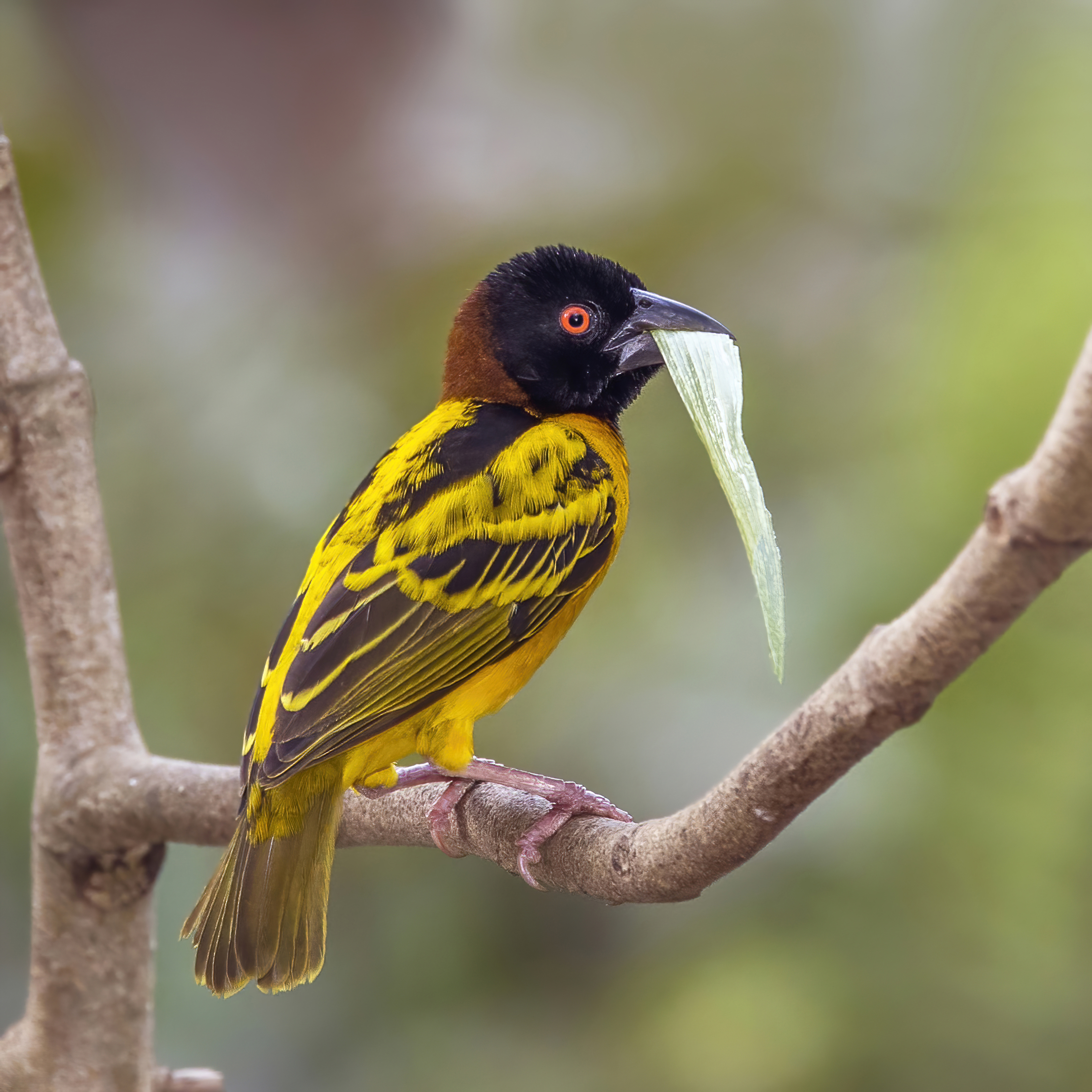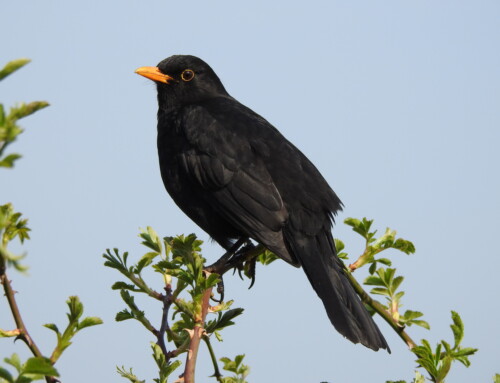 LINKED PAPER
LINKED PAPER
Supplementing a grain diet with insects instead of fruits sustains the body condition of an omnivorous bird. Simon, O. G., Manu, S. A., Nwaogu, C. J., & Omotoriogun, T. C. 2023 Ecology and Evolution. doi: 10.1002/ece3.10141 VIEW
Omnivory implies nutrient acquisition from plant and animal sources (Singer & Bernays, 2003). Dietary sources utilized by omnivores may differ widely in nutrient content and despite foraging on different food types, many omnivores have a primary diet. Hence, most avian omnivores may better be described as granivores, frugivores or herbivores that incorporate protein-rich insects into their diets to complement their primary plant diets (Burin et al. 2016).
While some omnivores must feed on supplementary diets (obligate omnivores), others do not necessarily require supplementation (facultative omnivores). Where omnivory is obligate, deprivation of supplementary diets crucial for body functions will lead to nutrient limitation, whereas facultative omnivores who can derive all required nutrients from their primary diet may be unaffected by such deprivation (Milne & Walter 1997; Gillespie et al. 2012). Environmental changes and occurrence of life history events such as breeding and moult are two factors that can lead to diet or nutrient limitations in birds with effects on morphology and physiology (Andersson et al. 2018). For example, dietary protein limitation may lead to the breakdown of protein-rich tissues including muscles and digestive organs.
Omnivorous birds in changing environments are useful surrogates for investigating how diet limitation and/or nutrient limitation due to environmental changes and timing of annual cycle events can influence body condition. Using the Village Weaver (Ploceus cucullatus) as our model species, we determined how deprivation of supplementary dietary items (insects and fruits) affect body condition in captivity in a recent paper published in Ecology and Evolution.
The species is an omnivorous tropical bird found throughout sub-Saharan Africa. Village Weavers are predominantly granivorous, but they also forage on insects and fruits. Male weavers are larger in size than females. Their omnivorous foraging behaviour makes them amenable to captive conditions and suitable for experimental diet manipulation. This allowed the effects of nutrient limitation (resulting from different dietary supplementation) on body condition to be determined.
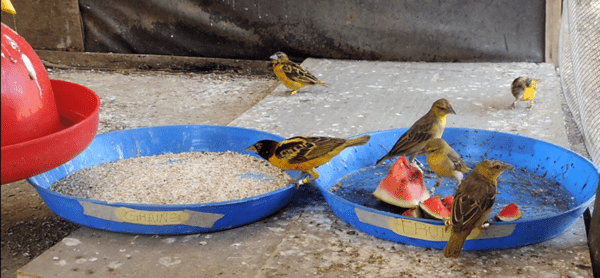
Figure 1 Village Weavers feeding within one of the captivity aviaries.
Forty wild-caught weavers (20 males and 20 females) held in aviaries were fed a combination of grains and fruits, or grains and insects ad libitum for eight weeks. Fortnightly, we assessed indices of body condition including body mass, pectoral muscle and fat scores, Packed Cell Volume (PCV) and Haemoglobin Concentration (HBC). We modelled body condition indices as functions of diet, while accounting for time (weeks) and sex effects. We expected a deterioration of body condition in weavers on both diet treatments if omnivory is obligate, and a more pronounced deterioration in weavers deprived of the more essential supplementary diet between insects and fruits.
Our findings
Weavers on both diet combinations lost body mass and accumulated fat. However, weavers fed on grains and fruits lost body and pectoral muscle mass and accumulated less fat than those fed on grains and insects. This effect was sex-dependent: females supplemented with fruits lost more pectoral muscle mass than males of the same group and males but not females, supplemented with insects accumulated more fat reserve than those supplemented with fruits. PCV and HBC did not differ between diets but increased over the eight weeks.
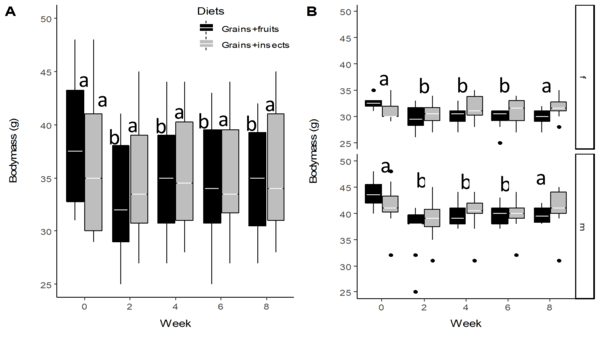
Figure 2 Effect of diet treatment on the body mass (g) of Village Weavers over eight weeks of experiment between (A) Diet types (B) Sexes (f = female, m = male). Boxes show group medians. Boxes for each diet with different letters are significantly different while different letters above boxes for sexes indicates a significant difference between weeks after post hoc comparisons at p < .05.
We found that body mass decreased for weavers on both diet treatments which implies that captivity and/or the diet combination provided in this study are suboptimal for the Village Weaver. However, it is worthy to note that the decrease in body mass was more pronounced in the fruit supplemented weavers, suggesting that a grain diet supplemented by insects may better satisfy nutrient requirements compared to a grain diet supplemented by fruit. This was also evident in the depletion of the pectoral muscle of weavers fed on grains and fruits for potential protein requirement. These effects were sex dependent with the larger size of the males influencing the rate at which body and pectoral muscle mass was lost.

Figure 3 Effect of diet treatment on the pectoral muscle size of Village Weavers over eight weeks of experiment between (A) Diet types (B) Sexes (f = female, m = male). Both sexes had higher and similar muscle scores on grains and insects than on grains and fruits diets. Bars with different letters are significantly different after post hoc comparisons at p < .05.
Increase in body fat may be due to the cold conditions during our experiment rather than diet treatment, but diet influenced the intensity of fat accumulation in response to environmental change. The lack of a dietary effect on PCV and HBC was unexpected, but both increased in response to the cold condition during our experiment.
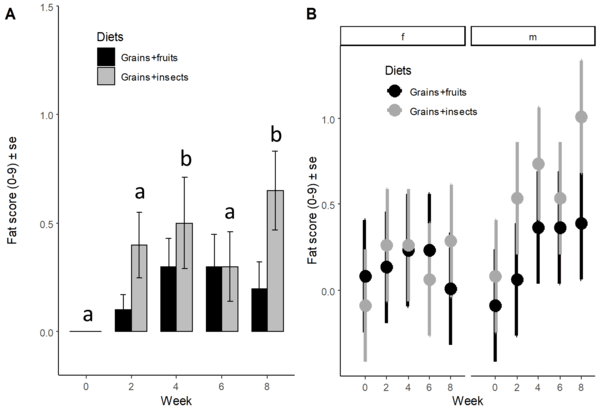
Figure 4 Effect of diet treatment on the fat score of Village Weavers over eight weeks of experiment between (A) Diet types (B) Sexes (f= female, m= male). Males differ in their fat score between diets but females do not. Differences in letter above each pair of bars indicate a significant difference between weeks after post hoc comparisons at p < .05.
Conclusion
Village Weavers are likely obligate rather than facultative omnivores, with insects being a more nutritive supplement than fruits. Environmental changes capable of altering the availability of different food types (especially insects) can affect the maintenance of body condition and other physiological processes. Obligate omnivores such as the Village Weaver, which depend on several food sources to meet its daily nutrient requirements, are particularly vulnerable. Moreover, omnivores may be more vulnerable to environmental change despite their diverse foraging options due to their complex diet combination (Burin et al. 2016).
References
Andersson, N., Piha, M., Meller, K., Välimäki, K., & Lehikoinen, A. 2018. Variation in body condition of songbirds during breeding season in relation to sex, migration strategy and weather. Ornis Fennica 95:70-81. VIEW
Burin, G., Kissling, W. D., Guimarães, P. R. Jr., Şekercioğlu, C. H., & Quental, T. B. 2016. Omnivory in birds is a macroevolutionary sink. Nature Communications 7:11250. VIEW
Gillespie, D. R., VanLaerhoven, S. L., McGregor, R. R., Chan, S., & Roitberg, B. D. 2012. Plant feeding in an omnivorous mirid, Dicyphus hesperus: why plant context matters. Psyche 2012:495805. VIEW
Milne, M., & Walter, G. H. 1997. The significance of prey in the diet of the phytophagous thrips, Frankliniella schultzei. Ecological Entomology 22:74-81. VIEW
Singer, M. S., & Bernays, E. A. 2003. Understanding omnivory needs a behavioral perspective. Ecology 84:2532-2537. VIEW
Image credit
Top right: Village Weaver (Ploceus cucullatus cucullatus) male with leaf for nest building, Kakum National Park, Ghana © Charles J. Sharp CC BY SA 4.0 Wikimedia Commons.
If you want to write about your research in #theBOUblog, then please see here.


